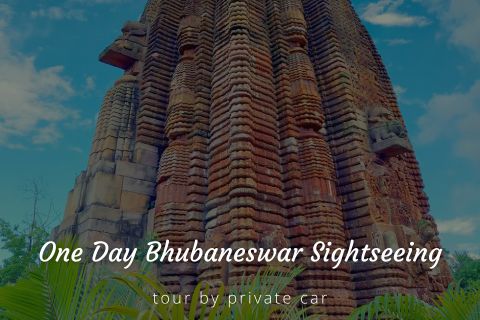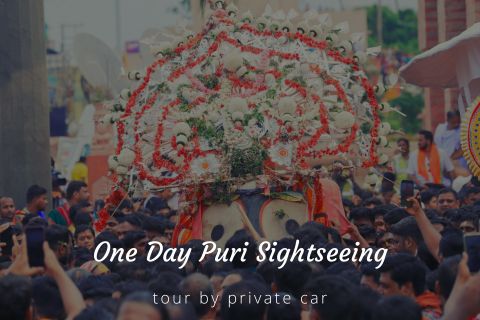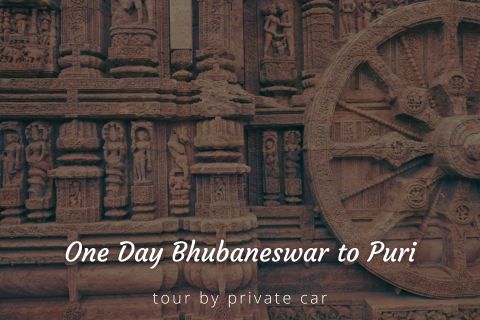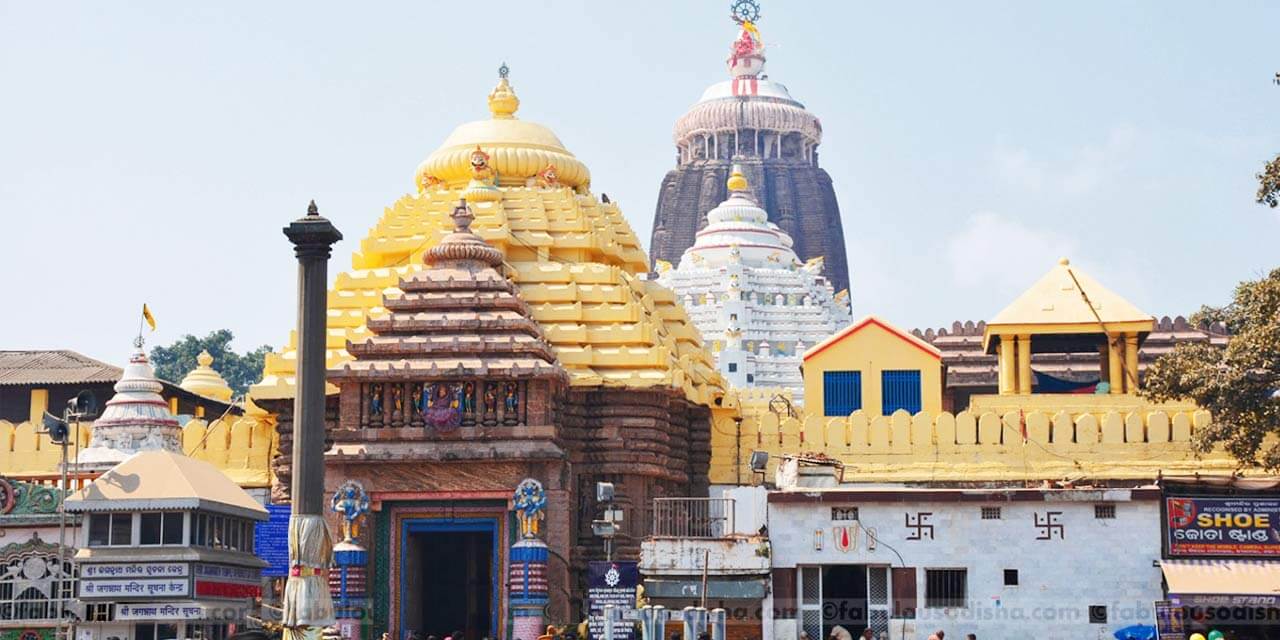Shree Jagannath Temple Puri Entry Fee
- No Entry Fee
Shree Jagannath Temple Puri Phone
N/A
Rating:  | 4/5 stars
| 4/5 stars
Based on total 32 reviews
Shree Jagannath Temple Puri Address: Shri Jagannath Temple, Chief Administration Office, Grand Rd, Puri, Odisha, 752001, India
Shree Jagannath Temple Puri Darshan & Timings
| Rituals | Timings |
|---|---|
| Dwarpitha and Mangal Aarati | 5:00 am |
| Mailam | 6:00 am |
| Abakash | 6:00 am to 6:30 am |
| Mailam | 6:45 am |
| Sahanamela | 7:00 am to 8:00 am |
| Beshalagi | 8:00 am |
| Rosha Homa Surya Puja and Dwarapal | 8:00 am to 8:30 am |
| Gopala Ballava Puja | 9:00 am |
| Sakala Dhupa(Morning food offering)Mailam | 10:00 am |
| Mailam & Bhoga Mandap (2 to 3 times a day) | Madhyanha Dhoop Sandhya Dhoop |
| Madhyanha (Afternoon food offering) | 11:00 am to 1:00 pm |
| Madhyanha Pahudha | 1:00 pm to 1:30 pm |
| Sandhya Aarati | 5:30 pm |
| Sandhya Dhupa | 7:00 pm to 8:00 pm |
| Mailam and Chandana lagi | 8:30 pm |
| Badashringara Vesha | After Chanadana Lagi |
| BadaShringar Laga Bhoga | 9:30 pm to 10:30 pm |
| Khata Seja Lagi and Pahuda | 12:00 am (Midnight) |
Shree Jagannath Temple in Puri, considered to be one of the four dhams (pilgrimages) of India, is located in the ancient city of Puri, in the state of Odisha. Dedicated to Lord Jagannath – the Lord of the Universe, a form of Lord Vishnu, this ancient temple receives millions of devotees each year. This number goes up exponentially during the famous Rath Yatra festival.
Featuring Kalinga architectural style, this shrine houses several small temples besides the main temple that has so many interesting stories associated with it. The principal deities in this sacred shrine are Lord Jagannath, his brother Lord Balabhadra and his sister Goddess Subhadhra. The architecture of the temple is simply outstanding and so are its age-old gates that offer a glimpse into the brilliant craftsmanship of the ancient era.
The Grand Road (Bada Danda) that leads to the Jagannath Temple remains crowded with devotees and buzzes with activities from morning to evening till late night. The whole atmosphere both inside and outside the temple, despite the rush, is simply outstanding. It is a holy place that is definitely worth visiting, once in a lifetime!
History of Shree Jagannath Temple Puri
According to folklore, prior to being known as Jagannath (Lord of the Universe), the Lord was worshiped as ‘Purushottama’ – the one who is the creator, the protector and the destroyer of the world. It is believed that the present structure of the Shree Jagannath Temple at Puri was built by King Ananta Varman Chodaganga Deva, who was the founder of the Ganga Dynasty, in the 12th century AD. However, the completion of the temple happened in 1230 AD under Anangbheema Deva III, who also installed the deities in the shrine.
Nabakalebara
Nabakalebara is a unique tradition of the Jagannath Temple that is performed periodically at 8, 11, 12 and 19 years. The word ‘Nabakalebara’ means new embodiment. This tradition, which is traced to some astrological and astronomical calculations, involves replacement of the wooden idols of the worshiped deities.
The process of Nabakalebara has 12 steps including traveling to a forest, finding the divine trees, cutting and shaping of the woods from the tree, brining the woods to Puri, making of the new idols, burial of the old idols and appearance of the new ones before the devotees.
Festivals
About 12 major festivals, along with others, are observed with great fervor in the temple and collectively they are called ‘Dvadasa Yatras’. These are Snana Yatra, Sayana Yatra, Parshwa Parivartana, Deva Utthapana, Daksinayana, Pushyavisheka, Pravarana Sasthi, Dola Yatra, Makar Sankranti, Chandana Yatra, Akshaya Tritiya, Damanaka Chaturdashi and Neeladri Mahodaya.
Rath Yatra
One of the most important celebrations at the Jagannath Temple in Puri is the famous Rath Yatra festival. Thousands of devotees throng to Puri each year to witness this grand celebration. This festival is celebrated on the second day of the Asadha month (as per the Hindu calendar). For this Chariot Festival, three chariots are constructed each year.
On the first day of the yatra, the idols of Lord Jagannath, Lord Balabhadra and Goddess Subhadhra are seated in separate chariots and carried with a grand procession to the Gundicha Temple - the aunt’s house of Lord Jagannath which is located only a few kilometers away. On the 10th day of the festival, the idols are brought back to the Jagannath Temple, and this return journey is called Bahuda Yatra.
Some of the other festivals celebrated in the temple are Shree Krushna Janma, Jhulan Yatra, Ganesh Chaturthi, Balabhadra Janma, Saptapuri Amabasya, Rahurekha Lagi, Badi Nrusimha Bije, Chitlagi Amabasya, Rishi Panchami, Holi, Ramnavami and others.
Image Gallery of Shree Jagannath Temple Puri
Architecture of Shree Jagannath Temple Puri
The main temple is located at the center of the inner courtyard on a raised platform. Built in Kalinga architectural style, the temple has four parts including Vimana, Jagamohana, Nata Mandapa and Bhoga Mandapa. The shrine has two temple structures – Rekha Deula and Pitha Deula, with the Vimana featuring Nagara type of Rekha Deula style while the Jagamohana featuring Pitha Deula style.
The Vimana has a Pancharatha ground plan with vertical shape at the bottom and curvilinear spire (Shikhar). Inside the Vimana, the idols of the main deities have been installed on a stone pedestal called Ratna Singhashana.
The entire shrine is surrounded by two huge concentric walls, while the inner wall is called ‘Kurma Prachira’ and the outer wall, which is 20 to 24 feet high, is called ‘Meghanada Prachira’. The outer wall has four gates – the east gate is known as Singha Dwara, west gate is called Vyaghra Dwara, north gate is called Hastidwara and south gate is known as Aswadwara.
There are a number of small temples and elevated platforms inside the premises. Besides these, there are seven wells, two gardens named Nilachala Upabana and Koili Baikuntha, a kitchen and a sacred banyan tree inside.
Inner Compound (Bhitara Bedha)
The inner compound of the shrine has as many as 76 sacred small temples, out of which the important ones are:
Vimala Temple
It is believed to be the oldest shrine in the inner compound. A famous Shakti Peeth, Vimala Temple houses an idol of four-armed Goddess Vimala, with one hand holding a Kalasa (Jar) while two others holding an Aksamala (Rosary) and human figure and the fourth one is in Varada Mudra (pose). An interesting aspect of this temple is that the Prasad which is offered to Lord Jagannath everyday is first offered to Goddess Vimala, and only then it is called Mahaprasad.
Agneeswara Temple
This temple is considered to be the guardian of the fire of the temple kitchen.
Satya Narayan Temple
This temple houses a four-armed granite idol of Shree Narayan, with a disc in one hand; conch and mace in the other two and fourth hand representing the Abhaya Mudra.
Lakshmi Temple
Believed to have been built by the Ganga Dynasty in the 12-13th century AD, Lakshmi Temple houses an idol of Goddess Gajalakshmi with four arms; the top two holding two elephants while the lower two representing Varada and Abhaya poses.
Shree Nrusimha Temple
Believed to be constructed prior to the Jagannath Temple, this temple is dedicated to Lord Nrusimha. It has a Pancharatha Rekha Deula style of architecture but without a prayer hall. The temple houses a small idol of the deity.
Surya Temple
Dedicated to the Sun God, this temple houses an image of Sun, which is believed to have been brought by King Narasimha Deva of the Bhoj Dynasty from the Konark Temple.
Bata Ganesha Temple
This temple, dedicated to Lord Ganesha, is located below the sacred banyan tree called Kalpabata, located in the premises.
Nrutta Ganapati Temple
Believed to be built in the 13th century AD, the Nrutta Ganapati Temple houses an eight-armed idol of Lord Ganesha in a dancing pose.
Bhubaneswari Temple
This temple houses an idol of Goddess Saraswati along with images of Goddesses Sasthi, Savitri and Gayatri.
Kalpabata
It is a huge banyan tree that lies on the southern side of the temple. There is a belief that devotees who circumambulate the tree and step on its shadow attain Kesavalaya, which means abode of Lord Vishnu.
Kanchi Ganesha
Dedicated to Lord Ganesha in the form of Bhanda Ganesha, this shrine houses a four-armed idol of the deity and an image of his consort on his lap. The image is believed to be a tantric image, which was brought by Gajapati Purushottama Dev from Kanchi.
Mukti Mandapa
Mukti Mandapa has 16 pillars and has a width of 38 feet and 38 feet in length. Only a few priests belonging to particular villages, Deula Purohita, Dandai Sanyasis, Jagadguru Sankarcharya and Rajgurus are entitled to sit on this platform.
Outer Compound (Bahara Bedha)
The outer compound features about 45 important parts of the temple premises, including:
Roshaghara (Kitchen)
Featuring about 250 Chulis (hearths), this kitchen is believed to be the largest of its kind in the world. Cooking in this kitchen is done in a traditional way using earthen pots and burning charcoal. Only the Suaras (Servitors) and their assistants are allowed to enter this kitchen. There are 32 rooms in the kitchen that are 20 feet high, 100 feet wide and 150 feet long. About 600 chefs and 400 assistants cook here on a daily basis.
Ananda Bazaar
This is the place in the premises where Mahaprasad is earmarked for sale, along with other popular, sacred sweet delicacies of Puri. Devotees can also sit and eat the Mahaprasad at a dedicated place in this part of the premises.
Aruna Sthamba
This monolith pillar with sixteen sides lies on the eastern side of the main temple. Measuring a height of 34 feet, this pillar was brought from the Konark Temple by King Dibyasingha Deva.
Baisi Pahacha
Baisi Pahacha meaning 22 steps denotes the flight of stairs leading from the outer compound to the inner compound of the temple. However, currently only 17 steps are visible due to the construction made at a later time. It is believed that devotees should sit on these steps as part of their sacred duty.
Patitapabana
A single image of Lord Jagannath is carved on the Singha Dwara called Patitapabana. This image has been carved here so that those devotees, who for some reason are unable to enter the temple, can do the darshan of the Lord.
Snana Mandapa
This is the pavilion where the bathing festival of the main deities is performed.
Some of the architectural wonders of the Jagannath Temple are:
- The construction of the main temple has been done in such a manner that at no time of the day, the shadow of the temple falls on the ground.
- The blue wheel (Nilachakra) perched on top of the shrine is made of eight metals (asta dhatu).
- The flag perched on top of the temple uniquely flows in the opposite direction of the wind.
Things to do in Shree Jagannath Temple Puri
There are some interesting things for visitors to witness at Shree Jagannath Temple in Puri that are sure to astound them.
Witnessing Changing of Flag Ritual
Every evening at sunset, the flag mounted on top of the main temple is changed. This has been done over 800 years, and the responsibility has been assigned to a family of priests by the Gajapati King. Every evening, one priest climbs the walls of the temple barefoot and with bare hands, without any equipment and changes the flag. The height of the temple is said to be equivalent to a 45 storey building.
No Shadow
An interesting thing to witness while in the premises is that at no time of the day, the shadow of the temple falls on the ground.
Same from all directions
Nilachakra or Sudarshan Chakra, which is too mounted on the top of the temple, when looked from below appears to be same from all directions.
Nothing Flies Above
Unlike other temple structures where birds can be seen sitting at the top, not a single bird can be seen resting or flying above the spire of the temple. Not even aircrafts can be seen flying over the temple.
Missing Sound of Sea
An interesting thing to notice after entering the gates of the shrine is that the sound of the sea waves is completely lost and can only be heard after coming out of the temple.
Opposite Breeze
During the day, the breeze blows from land to sea and in the evening, it blows from sea to land. This is exactly opposite to what happens everywhere in the world.
Magical Method to Cook
In the kitchen of the temple, there are about 250 hearths, where 56 food items for almost 20,000 people are cooked daily and 50,000 people on special occasions and not even a bite gets wasted. However, the most interesting aspect of the kitchen is that earthen pots are placed on top of each other, but the pot on the top is cooked first. However, visitors are not allowed to enter the kitchen, and the cooking technique of the temple is only known to the servitors, who are allowed to enter it.
Shopping
Besides exploring the temple, visitors can spend time purchasing local handicrafts items and different items related to Lord Jagannath as well as various delicacies of Puri at the market on the Grand Road. In addition, they can sit and relax in the newly built garden just outside the temple that has simply increased the charm of the place.
Shree Jagannath Temple Puri Timings and Entry fee
No fee is charged to visitors to enter the Shree Jagannath Temple in Puri. The Darshan of Lord Jagannath can be done all through the day, right from early morning till late night. However, there are exceptions during the festive occasions.
The temple doors are opened to the public at about 5.30 am. However, devotees are allowed for darshan of the Lord only after ‘Mangal Arati’. This darshan is made available from Bhitar Kaatha (Jagamohana/Prayer Hall) till completion of another ritual called ‘Besha’, which goes on till 7.30 or 8 am. Thereafter, darshan of the Lord is not available for about 1 hour 15 minutes, during which Gopal Ballava Puja is performed.
After this puja, darshan is available from Baahar Kaatha (Nata Mandir/Dance Hall) up to the completion of ‘Sakaal Dhoopa Puja’ till about 11 am. Thereafter, darshan is again available from Jagamohana up to the completion of ‘Bhoga Mandapa Puja’ till around 1 pm.
Devotees can get darshan of the deities from both Nata Mandir and Jagamohana from 2 pm to 5.30 pm, from ‘Madhyanha Dhoop’ to ‘Sandhya Alati’. The final darshan of the day is from the end of ‘Sandhya Dhoop’ to the end of the ritual called ‘Chandan Laagi’, which is from about 8 pm to 9 pm.
How to reach Shree Jagannath Temple Puri
Shree Jagannath Temple in Puri lies at an approximate distance of 2.8 km from the Puri Railway Station and only about 1.9 km from the Puri Bus Stand. Private taxis, auto rickshaws and cycle rickshaws can be easily availed from the railway station and the bus stand to reach the temple.
The closest airport to the temple is the Biju Patnaik International Airport, about 60 km away in the city of Bhubaneswar. Tourists can avail private taxis from top car rental companies in Bhubaneswar till Puri. Alternatively, they can head to the Bhubaneswar Railway Station to board any train leaving for Puri or else they can go to the bus stand near the railway station and catch a bus to Puri. It takes little over an hour to cover the distance between Bhubaneswar and Puri.
Things to keep in mind while visiting Shree Jagannath Temple Puri
- Non-Hindus are not allowed to enter the temple.
- Footwear, leather articles, mobile phones and cameras are not allowed inside the temple.
- Free mobile phone and shoe stands are available at the premises.
- Ambulance service as well as first-aid service with experienced doctors are available at the temple.
- Clean water facility is available in the complex.
- Free battery-operated vehicles are available for senior citizens and physically challenged persons from Market Square till the North Gate / Main Gate of the temple. Wheelchair and ramp facilities are also available at the premises.
A Bhubaneswar holiday with us is all about you. At Bhubaneswar Tourism, a division of Holidays DNA, we design each trip around your interests, whether you’re looking for a romantic getaway, an action-packed adventure or a relaxing break. We make sure you visit all the popular tourist attractions of Bhubaneswar and enjoy your vacation exactly how you want it. So, whether you want to book from our all-inclusive Bhubaneswar tour packages or create your own itinerary to suit your interests, trust booking your holiday with us. To know more, please fill the Contact Us form.






